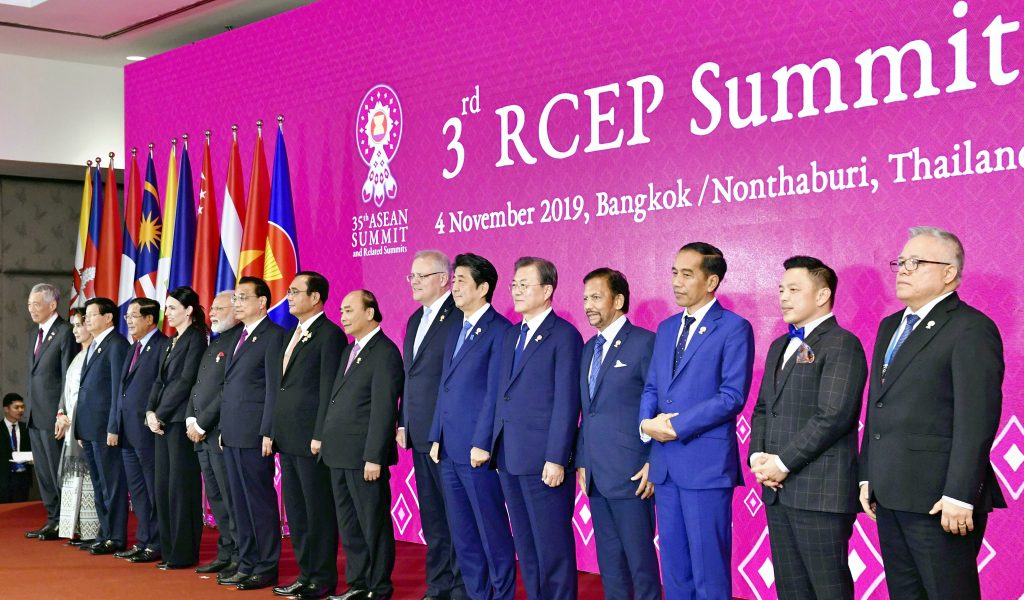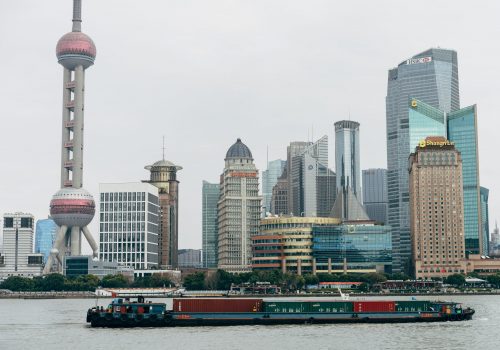The full text of this paper is split across the various articles linked below. Readers can browse in any order. To download a PDF version, use the button below.
Africa and Latin America are also in the process of forging regional trade agreements, though Latin American states have been more focused on pursuing numerous subregional and intra-regional accords. Over the past three decades, Africa has sprouted a host of subregional trade and customs agreements, principally reducing tariffs and facilitating customs cooperation [i.e. the Common Market for Eastern and Southern Africa (COMESA), the East African Community (EAC), the Economic Community of West African States (ECOWAS), the Southern African Development Community (SADC), the Arab Maghreb Union (UMA), and the Community of Sahel-Saharan States (CSSS)]. Reliant mainly on rents from extractive industries and agricultural exports, and processing agro-industry, Africa’s trade is concentrated outside the region, though intra-African trade has gradually increased from 10 percent in 1995 to 17 percent in 2017. In 2018, amidst economic uncertainty and protectionist winds, Africa launched a more ambitious, sweeping Africa Continental Free Trade Agreement (AfCFTA). With a potential market of nearly one billion people and a $3 trillion GDP, AfCTA, which took effect in 2019, will reduce nearly all tariffs, but also cover trade in services, investment, intellectual property rights (IPR), and competition policy. AfCFTA’s success will require diversification of economies, and improved governance and enforcement capacity. Key questions are whether the African market is large enough to absorb export-model industrial growth and the degree to which emerging technologies will allow Africa to leapfrog stages of development.
Latin America, whose vast majority of trade is with the United States, China, and the EU, has a similarly small amount of intraregional trade (17%) as Africa and lags on regional integration, with mainly subregional FTAs. The largest grouping is MERCOSUR (Argentina, Brazil, Paraguay, and Uruguay), which has eliminated most tariffs and adopted common external tariffs on imports outside the group. The combined GDP of MERCOSUR member states is $2.9 trillion. The second-largest grouping is the Pacific Alliance (Chile, Colombia, Mexico, and Peru), which has a combined GDP of $1.8 trillion. The Pacific Alliance has eliminated 92 percent of tariffs and is looking to sign FTAs with Asia-Pacific economies. The other subregional agreements are the Central America-Dominican Republic Free Trade Agreement (CAFTA-DR) and CARICOM, a common market comprising twenty Caribbean island states. There is an ongoing discussion within the region about establishing a Latin America-wide FTA. The Inter-American Development Bank (IDB) says such an FTA would increase the region’s economy by $11 billion. But Latin America exemplifies another trend: growing intra-regional trade accords, hedging against US economic nationalism and global uncertainty. Chile, Mexico, and Peru joined the Comprehensive and Progressive Agreement for Trans-Pacific Partnership (CPTPP), which evolved from the Trans-Pacific Partnership (TPP). Beyond Latin America, the EU-Japan Economic Partnership Agreement—an FTA between the world’s largest and fifth-largest economies, respectively—is the most consequential intra-regional accord. The EU has also been aggressively pursuing FTAs with Australia, Canada, MERCOSUR, Mexico, Singapore, Turkey, Vietnam, and other nations.
CPTPP and RCEP
Both Europe and Latin America are looking at the Asia-Pacific, a key driver of global growth, to expand trade and investment. Japanese Prime Minister Shinzo Abe has assumed a leadership role on this issue after Trump pulled the United States out of the TPP in January 2017. The TPP, pursued by the administrations of both George W. Bush and Barack Obama, was viewed as a pillar of US strategy in the Asia-Pacific. Trump’s rejection of it appeared to be an act of strategic incoherence and a product of his disdain for existing agreements. It was particularly odd from a geo-economic perspective as China is now the largest trading partner of every US ally and security partner in the AsiaPacific.
Well before Trump rejected the TPP, Abe demonstrated that upholding and updating the rules-based international order was a centerpiece of Japan’s foreign policy strategy. As such, his proactive effort to encourage the remaining members of the TPP (eleven, including Japan) to move ahead after the US withdrawal was unsurprising. The CPTPP, which took effect in January 2019, is one of the largest existing FTAs, representing about 13.5 percent of global GDP. [With US participation, the TPP would have represented nearly 40 percent of the global GDP.] The underlying political logic was that the TPP would set high standards that China would eventually need to adopt or lose markets. Although Japan has sought to persuade the United States to reconsider its opposition to the TPP, it has thus far been unsuccessful. For Japan, reinforcing the US-Japan alliance and global partnership is an important part of its overall national strategy.
The CPTPP and its regional complement and perhaps competitor, the Regional Comprehensive Economic Partnership (RCEP), is one of most consequential of the proliferating FTAs, driven to some degree by Asia-centered global supply chains. ASEAN has played a central role in the existing regional FTAs and in those currently under negotiation, which have grown from six in 1991 to 303 in force in 2020. RCEP, driven by ASEAN, embraced by China, and complementary to, and in some respects a competitor of, the CPTPP, is currently bogged down in slow-moving negotiations and is of lower quality in terms of standards and non-tariff issues when compared with the CPTPP. It is part of an effort to untangle the overlapping and confusing welter of bilateral FTAs—the Asian “noodle bowl.”
The CPTPP is a somewhat abridged version of the TPP. Twenty-two provisions from the original TPP agreement relating to intellectual property, investment, dispute settlements, new medicine and biologics, and endangered species were suspended under the CPTPP. The United States relentlessly pressed for each of these provisions prior to its withdrawal from the TPP. Other members of the TPP had readily accepted the US position and were willing to forgo their interests in favor of greater access to the US market. Once the United States withdrew from the TPP, rather than amending the agreement, Japan carefully sought to suspend provisions in the same areas that Washington had pushed for, simultaneously keeping the original agreement on the table but also creating a door through which the United States could rejoin the partnership in the future. Particularly sensitive issues, such as Malaysian concerns regarding state-owned enterprises’ (SOEs’) commitments and Brunei’s regarding coal-related services, were also suspended. Issues like Vietnam’s concerns about labor commitments and Canada’s trepidations about local cultural content were addressed through side letters.
Even absent these obligations, the CPTPP is still pioneering lofty standards for multilateral FTAs. Chapters on SOEs, government procurement, and e-commerce remain unaltered from the original agreement. Modeling by the Peterson Institute for International Economics (PIIE) projects that CPTPP countries would gain $147 billion by 2030. In contrast, PIIE’s simulation projected $492 billion in global income benefits if the United States had remained party to the TPP. No CPTPP nation gains from the absence of the United States, but the United States itself suffers the biggest net loss: the US economy goes from a projected gain of $131 billion from TPP-12 to a $2 billion loss as an outsider looking in on TPP-11.
While CPTPP nations have the same access to US markets as they did before the agreement, the United States has lost the preferential treatment it would have had had it remained in the agreement. US agricultural exporters and exporters of US-based services are losing out on expanded access to Asian markets. For example, CPTPP member Australia, one of the United States’ main agricultural export competitors, is enjoying tariff reductions on beef, dairy products, cereals and grains, sheep products, seafood, and rice.
In structuring the CPTPP, Abe has sought to facilitate a relatively painless US reentry. For example, the recent US-Japan bilateral trade accord, though limited in scope, adopted a number of standards (particularly, the digital accord) that are compatible with the CPTPP. This would facilitate a US entry into the CPTPP if it reversed course. If the United States returns, the CPTPP could simply activate the suspended provisions. Such a move would return the text of the agreement to the original language that the United States signed, but never ratified. One concern expressed by Japanese officials is that the United States would demand revisions and/or additions, such as a section on currencies.
Whether or not the United States enters the CPTPP, there is strong interest in the region and beyond to accede to the agreement. Indonesia, the Philippines, South Korea, Taiwan, and Thailand have all indicated an interest in joining the CPTPP, as has the United Kingdom. Despite unresolved historical issues between Japan and South Korea, Seoul has the easiest path as many of the provisions of the KORUS FTA are similar to those of the CPTPP and would require less negotiation and accommodation than other countries might face. China is, of course, the enormous missing ingredient. An expansion of the CPTPP and a US return to the agreement would create a compelling economic reality that would likely lead China to eventually accede to it.
An expansion of the CPTPP and a US return to the agreement would create a compelling economic reality that would likely lead China to eventually accede to it.
Regardless of the United States’ future plans, RCEP, in which China is a leading force, is slowly moving forward. It is an outgrowth of overlapping FTAs and requires that all members have an FTA with ASEAN. However, the existing ASEAN+1 FTAs are of varying scope and quality. RCEP never included the United States. And while it did include India, New Delhi dropped out of the talks in November 2019. RCEP members account for 32 percent of global exports and 28 percent of global GDP (both dominated by China). Seven of RCEP’s sixteen member states are also members of the CPTPP, a factor that may make it easier to eventually merge with the CPTPP and form a larger FTA for the Asia-Pacific (FTAAP), a long-term goal currently being studied by the Asia-Pacific Economic Cooperation (APEC).
While neither as far-reaching nor with as elevated standards as the CPTPP, RCEP currently includes many of the same areas as the CPTPP, including trade in goods, trade in services, investment, economic and technical cooperation, intellectual property, competition, dispute settlement, e-commerce, and small and medium-sized enterprises (SMEs). In the past, RCEP negotiations have stalled on several occasions over market access problems. India and others had been unable to agree on tariff schedule reductions and phase-outs. New Delhi’s absence may render the negotiations less problematic. RCEP also lacks agreements on IPR, digital commerce, and investment rules.
However, RCEP negotiators have reached only partial agreements on economic and technical cooperation and on SMEs. For example, China, Indonesia, and Vietnam have restrictive policies on investment in the technology sector that still need to be reconciled. In addition, under the terms of the negotiations, China, Japan, and South Korea need to complete an FTA before RCEP can move toward agreement. China’s mercantilist policies (see below) make that task difficult. One source of discord is the reality that RCEP countries are much more competitive than they are complementary with regard to the structure of their economies, producing similar agricultural, textile, electronic, and other goods in the regional supply chain. In addition, many of China’s fourteen FTAs, such as those it has with ASEAN and Thailand, have been at least as much political statements as they have been economic market openings.
The CPTPP’s launch may leave RCEP nations feeling pressured to finalize their accord. Since January 2019, the CPTPP has, in effect, stood as the benchmark for future trade agreements in the Asia-Pacific.
One important issue for Asia-Pacific nations is the relationship between global and regional trade liberalization. The former can catalyze the latter, and the latter can impede or complicate the former. Few expect another round of World Trade Organization (WTO) global trade liberalization. But efforts to liberalize certain sectors and trade processes (the Trade Facilitation Agreement, which entered into force in 2017; the Information Technology Agreement; the Trade in Services Agreement; and e-commerce talks) are likely to be the focus of the WTO. Any future where the WTO continues to play a central role in world trade is contingent upon substantive reform, including, most importantly, of what is viewed as its crown jewel—the dispute settlement system. Consensus on a global e-commerce accord would obviate the differences between the CPTPP and RCEP, and perhaps between China, the EU, and the United States on digital issues; the CPTPP chapter on digital commerce is the first effort at establishing comprehensive rules and could well serve as a building block for new global norms. The WTO is also engaged in talks to reach a global e-commerce accord. Seventy-six nations, including China, are participating in this effort. Talks have, however, stumbled on data localization issues. Alternatively, the United States could explore the possibility of direct digital commerce agreements with CPTPP members or the possibility of accession to the digital commerce chapter of the CPTPP.
Read the other post in this section: Technology trends are reshaping trade
Image: Members of Regional Comprehensive Economic Partnership(RCEP)including South Korea’s President Moon Jae-in (5th from R) and Japan's Prime Minister Shinzo Abe (6th from R) attend the 3rd RCEP Summit in Bangkok, Thailand on Nov. 4, 2019. ( The Yomiuri Shimbun )



